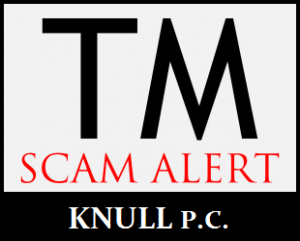By Chuck Knull

Scam artists are once again on the prowl to clip trademark owners who like to pay bills for useless services or who overreact to letters and emails telling them that their trademarks are in jeopardy. We have already received a bunch of inquiries from out clients about letters and emails they have received that either offer some extra service regarding their trademarks or imply that we, as their trademark attorneys, have missed deadlines that will cause the loss of the trademarks.
When we file trademarks for our clients, the filing information is publicly available at the U.S Patent and Trademark Office. This means that our name and address is listed as Attorney of Record and the name and address of the trademark owner is also available.
Legitimate concerns know to contact the attorney of record about the given trademark. People with illegitimate thoughts go to the name and address listed as the trademark owner. These people create official-sounding companies and send out official-looking communications intending to cause alarm.
The kinds of communications you might receive relating to so-called extra services are things like publishing your trademarks in a book, at a charge over $1000 per three month period. (This is supposed to “add” protection to the trademarks by making them publicly available.) Another offer we have seen is a service is to register domain names that include trademarks in various foreign countries, where, according to the offer, some local company is “just about” to take out these domain names and, by good fortune, the writer of the offer has discovered this is about to happen and put a hold on the domains until the fortunate trademark owner has the opportunity to send him a couple thousand dollars to register them.
Other offers come from so-called trademark service companies who will renew your trademarks, respond to office actions on your pending trademark applications, and the like. The prices for these proposed services are generally higher than what we charge per our fee schedule
We have even seen offers from a company that is sending out notices to trademark owners saying that not only have their trademarks been cancelled but also that someone else has jumped in and taken the marks (sort of a variation on the domain name scam mentioned above.)
You will not get what you think you are paying for. The offers that we have has reviewed are either worthless, such as the publication in the book noted above, which would have absolutely no effect upon the validity or strength of the trademark, or useless, such as the taking out of domain names in a foreign nation where one does no business, or counterproductive, or having a person unskilled in trademark law make filings at the USPTO.
If you receive any query regarding your trademarks that looks official but is directed to you rather than your trademark counsel, please assume it is a scam and send it on to your counsel.
14 Trademark Scams Uncovered
TM Collection – “International Register of Trademarks” – this one is a print version out of Hungary, but basically ths same scam.
TM Edition – “International Catalogue of Trademarks” – TM Collection by another name.
Patent Trademark Register – another “Registration of International Patents and Trademarks” but out of Austria.
Register of International Patents and Trademarks – another “Register of International Patents and Trademarks” but from Slovak Republic.
Trademark Renewal Service – “Trademark Cancellation Advisory” from a private company in D.C.
Trademark Safeguard – Trademark Monitoring Service – Order form for a monitoring service in NYC, “THE US PATENT AND TRADEMARK OFFICE HAS ALLOWED CONFUSINGLY SIMILAR NAMES TO BE REGISTERED.”
Intellectual Property Agency Ltd. – The British version of the renewal reminder.
As always, if you get something and you aren’t sure whether it is official USPTO correspondence or not, feel free to contact us and we will take a look.